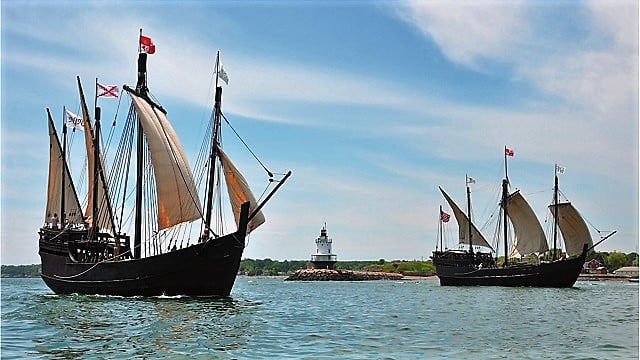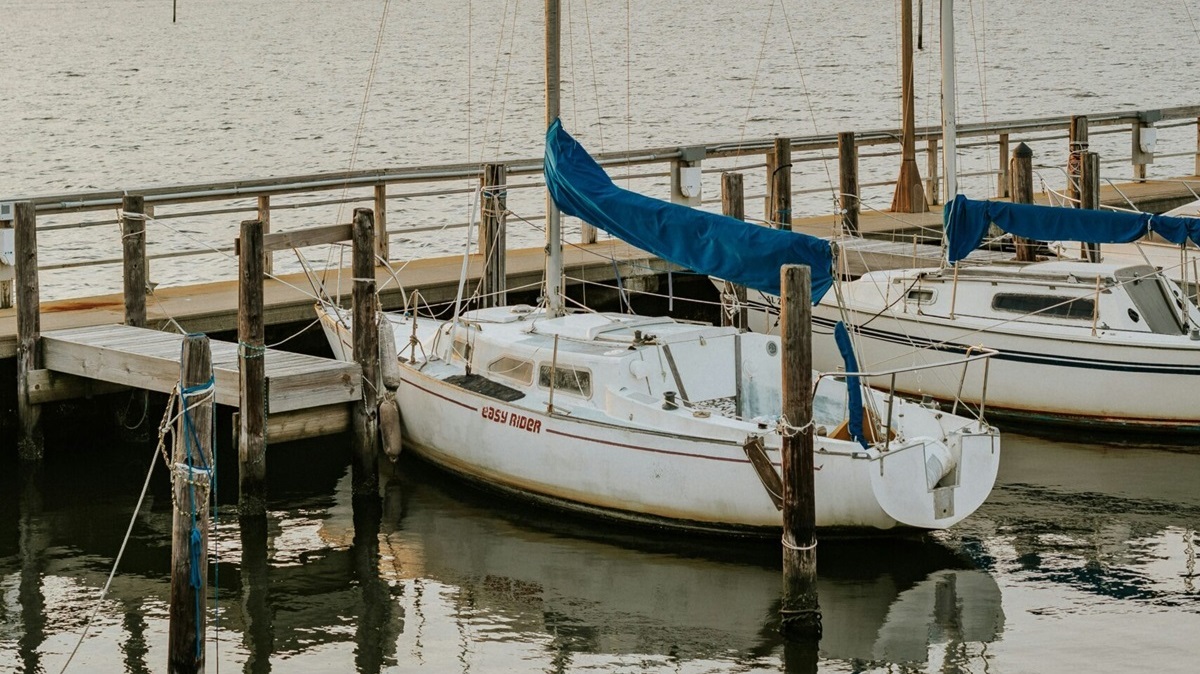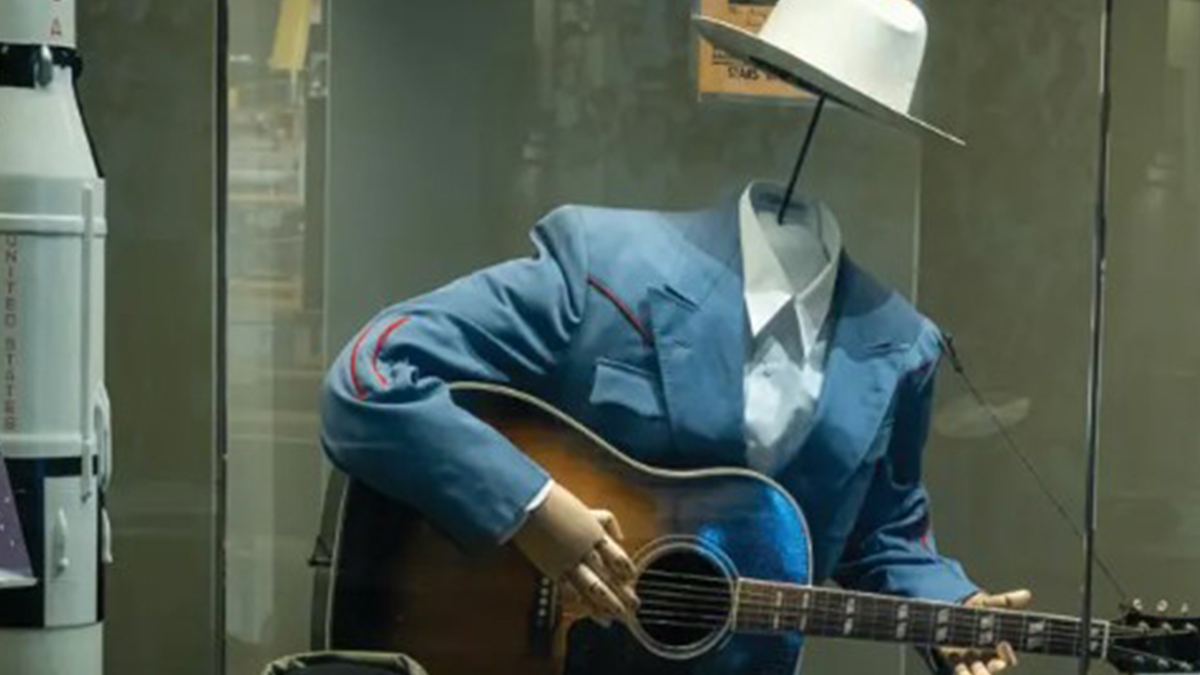Niña and Pinta replicas docked in Alabama through March 5

The Nina and Pinta replicas are docked in Orange Beach for a few days. (David Grimmel)
Step back in time to the 15th century this weekend and experience Christopher Columbus’s voyage to the New World.
The Niña and Pinta, replicas of the historic ships that carried Columbus from Spain to the New World in 1492, sailed into Orange Beach this afternoon. They will be docked at the Wharf and open for tours March 2-5.
The Niña and Pinta together are a floating museum designed to educate adults and children about the “caravel,” a Portuguese trading ship used by Columbus and other explorers. On his voyages, Columbus is credited with discovering the New World, dispelling the myth that the Earth was flat.
The touring ships visit 30 to 40 ports a year on the Gulf Coast, Eastern Seaboard, Great Lakes and midwestern rivers.
“It gives people an understanding of what it’s like to step back over 500 years ago into the shoes of a crew member who lived on one of those sailing ships,” said Stephen Sanger, captain of the Niña. “It’s an experience you can’t get in the classroom.”
The Columbus Foundation was established in the British Virgin Islands in 1986 to build the Niña, Pinta and Santa Maria to help celebrate the upcoming 500th anniversary of the explorer’s voyage across the Atlantic Ocean, Sanger said. But when money began to run out after two years of research, the foundation decided to focus on building one replica. The 65-foot-long Niña, which was constructed by hand and without the use of power tools, was declared by Archaeology magazine “the most historically correct Columbus ship ever built.”
In December 1991, the Niña, with 11 crew members, set sail for the first time, traveling more than 4,000 miles from Brazil to Costa Rica, where it appeared in the movie “1492,” directed by Ridley Scott.
“After that, people around the U.S. started calling and asking if the ship could be brought to their students, and that opened things up for tours,” said Sanger.
Then, in 2005, the Pinta was launched in Brazil and added to the fleet. The original Pinta was also a Portuguese caravel – a type of ship that historians have called the “space shuttle of the 15th century.”
Unlike its sister ship, the modern-day Pinta is not built to scale. The ship is 15 feet longer and 8 feet wider to provide additional deck space for walk-on tours. She is also equipped with an air-conditioned lower cabin perfect for onboard events and dockside charters.
The ships feature exhibits outlining the navigation techniques of the day, the history of the “Age of Discovery,” information about the workings of the vessels and a glimpse into life onboard 500 years ago.
“The best thing is that visitors will get to meet members of our volunteer crew,” said Sanger, adding that anyone can sign on as a volunteer crew member. “We have volunteer crew members who have been onboard for eight years, some for two years and some for only a month, and they all have a story to tell.”
Why isn’t the Santa Maria part of the fleet?
The Santa Maria, which was a different type of ship known as a nao, was much larger than the Niña and the Pinta. But what precludes it from becoming part of the fleet is that it cannot dock in shallow water, Sanger said.
“The Niña and Pinta only require a depth of 7 feet, and that means we can get up into rivers and channels,” he said. “The Santa Maria needs 14 feet of water. That would eliminate about 75 percent of the places we visit.”
Floating pieces of history
Columbus made four voyages in 12 years on caravel ships like the Niña and Pinta.
The Santa Maria ran aground and sank on Christmas Eve 1492 in Hispanola (now Cap-Haitien). The Pinta, on the other hand, returned home from the voyage.
Columbus’ favorite ship was the Niña, which logged 25,000 miles under his command. He later selected her as his flagship out of 17 vessels that traveled to explore Cuba, and Columbus bought a half-share in the Niña. After a voyage to the Pearl Coast in 1501, she disappeared from history.
An unforgettable experience
While at the Wharf March 2-5, the crew of the Niña and Pinta will welcome visitors for self-guided tours from 9 a.m. to 5:30 p.m. Admission is $8.50 for adults, $7.50 for seniors and $6.50 for students, ages 5-16. Children 4 and under are free.
Teachers or organizations can book a 30-minute guided tour with a crew member by calling 787-672-2152, or visiting www.ninapinta.org and clicking on “Take a Tour.”
After the ships leave Orange Beach early Tuesday morning, they will continue into Florida, making stops along the Gulf Coast and Atlantic Ocean, Sanger said. They will eventually circle back to sail up the Tombigbee and Ohio rivers.
“We are thrilled about the arrival and dockage of the Niña and Pinta replicas here at The Wharf,” said Jim Bibby, general manager of the Wharf. “This is such an exciting opportunity for us as a destination and for the community as a whole to enjoy such a uniquely enriching historical experience. I hope everyone takes the time to come aboard these stunning reproductions while they are at the Wharf Marina.”



























